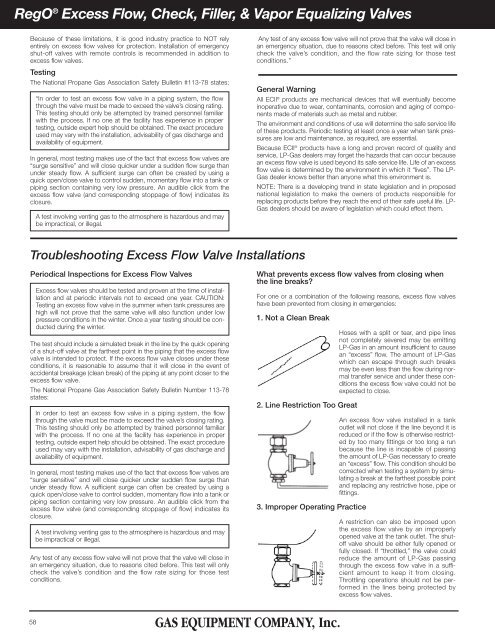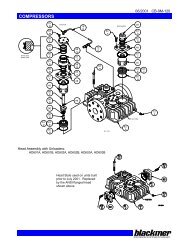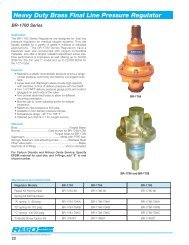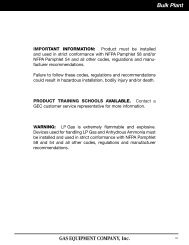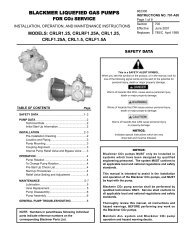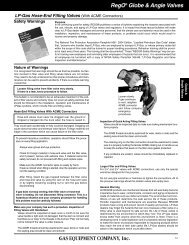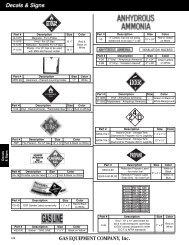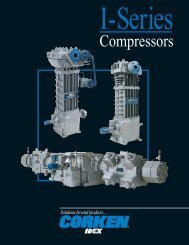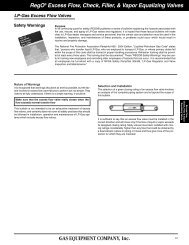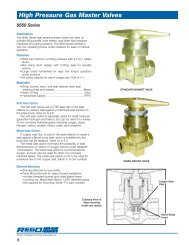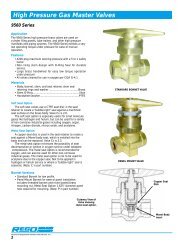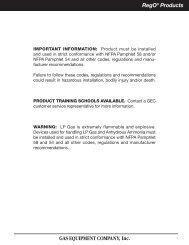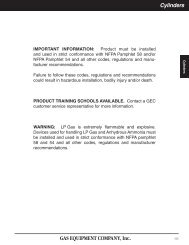RegO® Cylinder & Service Valves - Gas Equipment Company, Inc.
RegO® Cylinder & Service Valves - Gas Equipment Company, Inc.
RegO® Cylinder & Service Valves - Gas Equipment Company, Inc.
You also want an ePaper? Increase the reach of your titles
YUMPU automatically turns print PDFs into web optimized ePapers that Google loves.
RegO ® Excess Flow, Check, Filler, & Vapor Equalizing <strong>Valves</strong><br />
Because of these limitations, it is good industry practice to NOT rely<br />
entirely on excess flow valves for protection. Installation of emergency<br />
shut-off valves with remote controls is recommended in addition to<br />
excess flow valves.<br />
Testing<br />
The National Propane <strong>Gas</strong> Association Safety Bulletin #113-78 states:<br />
“In order to test an excess flow valve in a piping system, the flow<br />
through the valve must be made to exceed the valve’s closing rating.<br />
This testing should only be attempted by trained personnel familiar<br />
with the process. If no one at the facility has experience in proper<br />
testing, outside expert help should be obtained. The exact procedure<br />
used may vary with the installation, advisability of gas discharge and<br />
availability of equipment.<br />
In general, most testing makes use of the fact that excess flow valves are<br />
“surge sensitive” and will close quicker under a sudden flow surge than<br />
under steady flow. A sufficient surge can often be created by using a<br />
quick open/close valve to control sudden, momentary flow into a tank or<br />
piping section containing very low pressure. An audible click from the<br />
excess flow valve (and corresponding stoppage of flow) indicates its<br />
closure.<br />
A test involving venting gas to the atmosphere is hazardous and may<br />
be impractical, or illegal.<br />
Any test of any excess flow valve will not prove that the valve will close in<br />
an emergency situation, due to reasons cited before. This test will only<br />
check the valve’s condition, and the flow rate sizing for those test<br />
conditions.”<br />
General Warning<br />
All ECII ® products are mechanical devices that will eventually become<br />
inoperative due to wear, contaminants, corrosion and aging of components<br />
made of materials such as metal and rubber.<br />
The environment and conditions of use will determine the safe service life<br />
of these products. Periodic testing at least once a year when tank pressures<br />
are low and maintenance, as required, are essential.<br />
Because ECII ® products have a long and proven record of quality and<br />
service, LP-<strong>Gas</strong> dealers may forget the hazards that can occur because<br />
an excess flow valve is used beyond its safe service life. Life of an excess<br />
flow valve is determined by the environment in which it “lives”. The LP-<br />
<strong>Gas</strong> dealer knows better than anyone what this environment is.<br />
NOTE: There is a developing trend in state legislation and in proposed<br />
national legislation to make the owners of products responsible for<br />
replacing products before they reach the end of their safe useful life. LP-<br />
<strong>Gas</strong> dealers should be aware of legislation which could effect them.<br />
Troubleshooting Excess Flow Valve Installations<br />
Periodical Inspections for Excess Flow <strong>Valves</strong><br />
Excess flow valves should be tested and proven at the time of installation<br />
and at periodic intervals not to exceed one year. CAUTION:<br />
Testing an excess flow valve in the summer when tank pressures are<br />
high will not prove that the same valve will also function under low<br />
pressure conditions in the winter. Once a year testing should be conducted<br />
during the winter.<br />
The test should include a simulated break in the line by the quick opening<br />
of a shut-off valve at the farthest point in the piping that the excess flow<br />
valve is intended to protect. If the excess flow valve closes under these<br />
conditions, it is reasonable to assume that it will close in the event of<br />
accidental breakage (clean break) of the piping at any point closer to the<br />
excess flow valve.<br />
The National Propane <strong>Gas</strong> Association Safety Bulletin Number 113-78<br />
states:<br />
In order to test an excess flow valve in a piping system, the flow<br />
through the valve must be made to exceed the valve’s closing rating.<br />
This testing should only be attempted by trained personnel familiar<br />
with the process. If no one at the facility has experience in proper<br />
testing, outside expert help should be obtained. The exact procedure<br />
used may vary with the installation, advisability of gas discharge and<br />
availability of equipment.<br />
In general, most testing makes use of the fact that excess flow valves are<br />
“surge sensitive” and will close quicker under sudden flow surge than<br />
under steady flow. A sufficient surge can often be created by using a<br />
quick open/close valve to control sudden, momentary flow into a tank or<br />
piping section containing very low pressure. An audible click from the<br />
excess flow valve (and corresponding stoppage of flow) indicates its<br />
closure.<br />
A test involving venting gas to the atmosphere is hazardous and may<br />
be impractical or illegal.<br />
Any test of any excess flow valve will not prove that the valve will close in<br />
an emergency situation, due to reasons cited before. This test will only<br />
check the valve’s condition and the flow rate sizing for those test<br />
conditions.<br />
What prevents excess flow valves from closing when<br />
the line breaks?<br />
For one or a combination of the following reasons, excess flow valves<br />
have been prevented from closing in emergencies:<br />
1. Not a Clean Break<br />
2. Line Restriction Too Great<br />
3. Improper Operating Practice<br />
Hoses with a split or tear, and pipe lines<br />
not completely severed may be emitting<br />
LP-<strong>Gas</strong> in an amount insufficient to cause<br />
an “excess” flow. The amount of LP-<strong>Gas</strong><br />
which can escape through such breaks<br />
may be even less than the flow during normal<br />
transfer service and under these conditions<br />
the excess flow valve could not be<br />
expected to close.<br />
An excess flow valve installed in a tank<br />
outlet will not close if the line beyond it is<br />
reduced or if the flow is otherwise restricted<br />
by too many fittings or too long a run<br />
because the line is incapable of passing<br />
the amount of LP-<strong>Gas</strong> necessary to create<br />
an “excess” flow. This condition should be<br />
corrected when testing a system by simulating<br />
a break at the farthest possible point<br />
and replacing any restrictive hose, pipe or<br />
fittings.<br />
A restriction can also be imposed upon<br />
the excess flow valve by an improperly<br />
opened valve at the tank outlet. The shutoff<br />
valve should be either fully opened or<br />
fully closed. If “throttled,” the valve could<br />
reduce the amount of LP-<strong>Gas</strong> passing<br />
through the excess flow valve in a sufficient<br />
amount to keep it from closing.<br />
Throttling operations should not be performed<br />
in the lines being protected by<br />
excess flow valves.<br />
58


